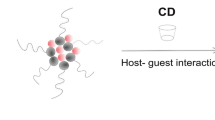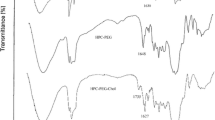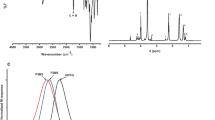Abstract
A novel amphiphilic biopolymer was synthesized by incorporating hydrophobic segment cholic acid (CA) into hydrophilic segment carboxymethyl xylan (CX) through coupling agent. Structural characteristics and self-assembly behaviors of the amphiphilic conjugates in aqueous solution were investigated in detail. Results showed that the conjugates provided monodispersed self-assembled micelles in distilled water, with average diameters in the range of 90–135 nm, depending on the DS of CA. TEM and AFM images proved that the self-assembly micelles were spherical. The micelles were covered with negatively charged carboxymethyl xylan shells, exhibiting zeta potential about − 38 mV. The aggregation concentration of the conjugate (0.0079–1.25 × 10−2 g/L) was closely related to the DS of CA and solution pH. Moreover, CX–CA nanoparticles were sensitive to the pH of release media. The cellular uptake of DOX-loaded CX–CA nanoparticles was better than that of free DOX, and thus CX–CA nanoparticles can be used as a new carrier for antitumor drug delivery.





Similar content being viewed by others
References
Akhlaghi SP, Peng B, Yao Z, Tam KC (2013) Sustainable nanomaterials derived from polysaccharides and amphiphilic compounds. Soft Matter 9:7905–7918
Alexander R, Wang H, Christopher VS, Valerie J, Seema A, Dmitry VP, Axel HEM, Ruth F (2017) Compaction and transmembrane delivery of pDNA: differences between I-PEI and two types of amphiphilic block copolymers. Biomacromolecules 18:808–818
Anju G, William S, Gregory TS, Donald H, Eric AM (2017) Rheological and thermo-mechanical properties of poly(lactic acid)/lignin-coated cellulose nanocrystal composites. ACS Sustain Chem Eng 5:1711–1720
Anna E, Zdenka H, Vera H, Xu CL, Bjarne H, Anna S, Stefan W (2008) Norway spruce galactoglucomannans exhibiting immunomodulating and radical-scavenging activities. Int J Biol Macromol 42:1–5
Cao XF, Peng XW, Zhong LX, Sun RC (2014) Multiresponsive hydrogels based on xylan-type hemicelluloses and photoisomerized azobenzene copolymer as drug delivery carrier. J Agric Food Chem 62:10000–10007
Davis ME (2009) Design and development of IT-101, a cyclodextrin-containing polymer conjugate of camptothecin. Adv Drug Deliv Rev 61:1189–1192
Ebringerová A, Sroková I, Talába P, Kačuráková M, Hromádková Z (1998) Amphiphilic beechwood glucuronoxylan derivatives. J Appl Polym Sci 67:1523–1530
Elquio EO, Acarilia ES, Toshiyuki NJ, Monique CSG, Larissa MA, Henrique RM, Ivonete BA, Marc PB, Nagila MPSR, Anselmo GO, Eryvaldo STE (2010) Xylan from corn cobs, a promising polymer for drug delivery: production and characterization. Bioresour Technol 101:5402–5406
Fatemeh B, Yaman B, Phillip C (2016) Effect of humidity on the permeability of alcohols in hydroxypropyl xylan films. ACS Sustain Chem Eng 4:2578–2583
Gwak SJ, Macks C, Jeong DU, Kindy M, Lynn M, Webb K, Lee JS (2017) RhoA knockdown by cationic amphiphilic copolymer/siRhoA polyplexes enhances axonal regeneration in rat spinal cord injury model. Biomaterials 121:155–166
Hassani LN, Hendra F, Bouchemal K (2012) Auto-associative amphiphilic polysaccharides as drug delivery systems. Drug Discov Today 17:608–614
Heinze T, Koschella A (2005) Carboxymethyl ethers of cellulose and starch—a review. Macromol Symp 223:13–40
Higuchi T, Connors KA (1965) Phase-solubility techniques. Adv Anal Chem Instrum 4:117–212
Jiang GB, Quan D, Liao K, Wang H (2006) Preparation of polymeric micelles based on chitosan bearing a small amount of highly hydrophobic groups. Carbohydr Polym 66:514–520
Kalyanasundaram K, Thomas JK (1977) Environmental effects on vibronic band intensities in pyrene monomer fluorescence and their application in studies of micellar systems. J Am Chem Soc 99:2039–2044
Kardośová A, Malovíková A, Pätoprstý V, Matáková T (2002) Structural characterization and antitussive activity of a glucuronoxylan from Mahonia aquifolium (Pursh) Nutt. Carbohydr Polym 47:27–33
Kwon K, Auh JH, Kim JW, Park KH, Park CH, Ko CJ (1997) Physicochemical properties and functionality of highly carboxymethylated starch. Starch/Starke 49:499–505
Li L, Wang N, Jin X, Deng R, Nie SH, Sun L, Wu QJ, Wei YQ, Gong CY (2014) Biodegradable and injectable in situ cross-linking chitosan-hyaluronic acid based hydrogels for postoperative adhesion prevention. Biomaterials 35:3903–3917
Liu LH, Guo K, Lu J, Venkatraman SS, Luo D (2008) Biologically active core/shell nanoparticles self-assembled from cholesterol-terminated PEG–TAT for drug delivery across the blood–brain barrier. Biomaterials 29:1509–1517
Liu J, Gary CC, Cheng F, Xu WY, Stefan W, Kristin S, Xu CL (2016) Hemicellulose-reinforced nanocellulose hydrogels for wound healing application. Cellulose 23:3129–3143
Luo J, Chen Y, Zhu XX (2009) Invertible amphiphilic molecular pockets made of cholic acid. Langmuir 25:10913–10917
Mäkeläinen H, Forssten S, Saarinen M, Stowell J, Rautonen N, Ouwehand AC (2010) Xylo-oligosaccharides enhance the growth of bifidobacteria and Bifidobacterium lactis in a simulated colon model. Benef Microbes 1:81–91
Melo-Silveira RF, Fidelis GP, Costa MSSP, Telles CBS, Dantas-Santos N, Elias SO, Ribeiro VB, Barth AL, Macedo AJ, Leite EL, Rocha HAO (2012) In vitro antioxidant, anticoagulant and antimicrobial activity and in inhibition of cancer cell proliferation by xylan extracted from corn cobs. Int J Mol Sci 13:409–426
Methacanon P, Chaikumpollert O, Thavorniti P, Suchiva K (2003) Hemicellulosic polymer from vetiver grass and its physicochemical properties. Carbohydr Polym 54:335–342
Moine C, Krausz P, Chaleix V, Sainte-Catherine O, Kraemer M, Gloaguen V (2007) Structural characterization and cytotoxic properties of a 4-O-methylglucuronoxylan from castanea sativa. J Nat Prod 70:60–66
Ogawa K, Takeuchi M, Nakamura N (2005) Immunological effects of partially hydrolyzed arabinoxylan from corn husk in mice. Biosci Biotech Biochem 69:19–25
Oliveira EE, Silva AE, Júnior TN (2010) Xylan from corn cobs, a promising polymer for drug delivery: production and characterization. Bioresour Technol 101:5402–5406
Pan Y, Ren XT, Wang S, Li X, Luo XL, Yin ZN (2017) Annexin V-conjugated mixed micelles as a potential drug delivery system for targeted thrombolysis. Biomacromolecules 18:865–876
Park K, Kim K, Kwon IC, Kim SK, Lee S, Lee DY, Byun Y (2004) Preparation and characterization of self-assembled nanoparticles of heparin-deoxycholic acid conjugates. Langmuir 20:11726–11731
Peng P, She D (2014) Isolation, structural characterization, and potential applications of hemicelluloses from bamboo: a review. Carbohydr Polym 112:701–720
Peng XW, Ren JL, Zhong LX, Cao XF, Sun RC (2011) Microwave-induced synthesis of carboxymethyl hemicelluloses and their rheological properties. J Agric Food Chem 59:570–576
Rajendra A, Manickam J (2017) Development of l-tyrosine-based enzyme-responsive amphiphilic poly(ester-urethane) nanocarriers for multiple drug delivery to cancer cells. Biomacromolecules 18:189–200
Ren F, Cigdem Y, Zhang ZF, Marga CL (2017) Functional PEG-hydrogels convey gold nanoparticles from silicon and aid cell adhesion onto the nanocomposites. Chem Mater 29:2008–2015
Šandula J, Kogan G, Kačuráková M, Machová E (1999) Microbial (1 leads to 3)-beta-D-glucans, their preparation, physico-chemical characterization and immunomodulatory activity. Carbohydr Polym 38:247–253
Shrinivas V, Jeremy PKT, Victor WLN, Eddy WPT, James LH, Yang YY (2017) Amphiphilic and hydrophilic block copolymers from aliphatic N-substituted 8-membered cyclic carbonates: a versatile macromolecular platform for biomedical applications. Biomacromolecules 18:178–188
Silva AKA, da Silva EL, Oliveira EE, Nagashima JT, Soares LAL, Medeiros AC, Araujo JH, Araujo IB, Carrico AS, Egito EST (2007) Synthesis and characterization of xylan-coated magnetite microparticles. Int J Pharm 334:42–47
Tork MB, Khalilzadeh R, Kouchakzadeh H (2017) Efficient harvesting of marine chlorella vulgaris microalgae utilizing cationic starch nanoparticles by response surface methodology. Bioresour Technol 243:583–588
Valente TAM, Silva DM, Gomes PS, Fernandes MH, Santos JD, Sencades V (2016) Effect of sterilization methods on electrospun poly(lactic acid) (PLA) fiber alignment for biomedical applications. ACS Appl Mater Interfaces 8:3241–3249
Vidhya N, Amar KM, Manjusri M (2016) Perspective on polylactic acid (PLA) based sustainable materials for durable applications: focus on toughness and heat resistance. ACS Sustain Chem Eng 4:2899–2916
Wang JQ, Zhang FJ, Tsang WP, Wan C, Wu C (2017) Fabrication of injectable high strength hydrogel based on 4-arm star PEG for cartilage tissue engineering. Biomaterials 120:11–21
Xiong Y, Qi J, Yao P (2012) Amphiphilic cholic-acid-modified dextran sulfate and its application for the controlled delivery of superoxide dismutase. Macromol Biosci 12:515–524
Xu F, Li H, Luo YL, Tang W (2017) Redox-responsive self-assembly micelles from poly(n-acryloylmorpholine-block-2-acryloyloxyethyl ferrocenecarboxylate) amphiphilic block copolymers as drug release carriers. ACS Appl Mater Interfaces 9:5181–5192
Yu C, Zhen X, Zhao H, Tang YF, Ji Y, Lyu Y, Fan Q, Huang W (2017) Amphiphilic semiconducting oligomer for near-infrared photoacoustic and fluorescence imaging. ACS Appl Mater Interfaces 9:12332–12339
Zhang J, Junk MJN, Luo J, Hinderberger D, Zhu XX (2010) 1,2,3-Triazole-containing molecular pockets derived from cholic acid: the influence of structure on host–guest coordination properties. Langmuir 26:13415–13421
Zhang J, Li X, Li X (2012) Stimuli-triggered structural engineering of synthetic and biological polymeric assemblies. Prog Polym Sci 37:1130–1176
Zhang P, Qian XP, Zhang ZK, Li C, Xie C, Wu W, Jiang XQ (2017) Supramolecular amphiphilic polymer-based micelles with seven armed polyoxazoline coating for drug delivery. ACS Appl Mater Interfaces 9:5768–5777
Acknowledgments
We wish to thank for the National Natural Science Foundation of China (31430092, 21404043, 21336002), Guangdong Natural Science Funds for Distinguished Young Scholar (2015A010105005), Tip-top Scientific and Technical Innovative Youth Talents of Guangdong special support program (2015TQ01C488), Science and Technology Program of Guangdong (2015A010105005), State Key Laboratory of Pulp and Paper Engineering (2017TS03) and Fundamental Research Funds for the Central Universities.
Author information
Authors and Affiliations
Corresponding author
Electronic supplementary material
Below is the link to the electronic supplementary material.
Rights and permissions
About this article
Cite this article
Peng, X., Xiang, Z., Du, F. et al. Amphiphilic xylan–cholic acid conjugates: synthesis and self-assembly behaviors in aqueous solution. Cellulose 25, 245–257 (2018). https://doi.org/10.1007/s10570-017-1595-0
Received:
Accepted:
Published:
Issue Date:
DOI: https://doi.org/10.1007/s10570-017-1595-0




